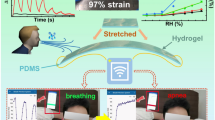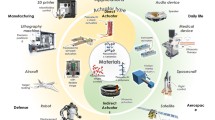Abstract
Piezoelectric energy harvesting which scavenges electric power from ambient vibration energy has received significant attention as an ultimate solution to realize self-powered wireless sensors. For designing a piezoelectric energy harvester, it is of great importance to develop a high-fidelity electromechanical model which predicts the output power under various vibration conditions. To the best of our knowledge, however, there has been no systematic approach to account for variability in the material properties and geometry of a piezoelectric energy harvester. This paper thus presents (1) the hierarchical model calibration to improve the predictive capability of the electromechanical model and (2) the design of energy harvesting (EH) skin to maximize the output power to reliably operate self-powered wireless sensors. In this study, the hierarchical model calibration infers statistical information of unknown model variables (compliance, piezoelectric strain coefficient, and relative permittivity). The calibrated electromechanical model is then used to design EH skin based on the piezoelectric material segmentation to avoid voltage cancellation. The output power predicted by the calibrated electromechanical model is statistically compared with the measured one. Finally, it is concluded from the feasibility demonstration that EH skin can sufficiently generate the output power to realize self-powered wireless sensors without batteries.












Similar content being viewed by others
Abbreviations
- S ij :
-
Strain
- T kl :
-
Stress
- E k :
-
Electric field
- D i :
-
Electric displacement
- s E ijkl :
-
Compliance of PZT
- d kij :
-
Piezoelectric strain coefficient
- ε T ik :
-
Relative permittivity at constant stress
- E brass :
-
Young’s modulus of brass
- ρ PZT :
-
Density of PZT
- ρ brass :
-
Density of brass
- T PZT :
-
Thickness of PZT
- T brass :
-
Thickness of brass
- ζ :
-
Mechanical damping ratio
- Δω :
-
Half-power bandwidth
- ω n :
-
Natural frequency
- θ :
-
Calibration parameter vector
References
Aridogan U, Basdogan I, Erturk A (2014) Analytical modeling and experimental validation of a structurally integrated piezoelectric energy harvester on a thin plate. Smart Mater Struct 23:045039
Beeby SP, Tudor MJ, White NM (2006) Energy harvesting vibration sources for microsystems applications. Meas Sci Technol 17:R175–R195. doi:10.1088/0957-0233/17/12/r01
Choi J, Lee W, Park J, Youn B (2008) A study on robust design optimization of layered plate bonding process considering uncertainties. Struct Multidiscip Optim 35:531–540
Dai C-L, Xiao F-Y, Lee C-Y, Cheng Y-C, Chang P-Z, Chang S-H (2004) Thermal effects in PZT: diffusion of titanium and recrystallization of platinum. Mater Sci Eng A 384:57–63
De Marqui Junior C, Erturk A, Inman DJ (2009) An electromechanical finite element model for piezoelectric energy harvester plates. J Sound Vib 327:9–25
Erturk A, Inman DJ (2009) An experimentally validated bimorph cantilever model for piezoelectric energy harvesting from base excitations. Smart Mater Struct 18:025009
Erturk A, Inman DJ (2011) Piezoelectric energy harvesting. Wiley, Chichester
Glynne-Jones P, White NM (2001) Self-powered systems: a review of energy sources. Sens Rev 21:91–98
Goldschmidtboeing F, Woias P (2008) Characterization of different beam shapes for piezoelectric energy harvesting. J Micromech Microeng 18:104013
Hu C, Youn BD (2011) Adaptive-sparse polynomial chaos expansion for reliability analysis and design of complex engineering systems. Struct Multidiscip Optim 43:419–442. doi:10.1007/s00158-010-0568-9
Hu C, Youn BD, Yoon H (2013) An adaptive dimension decomposition and reselection method for reliability analysis. Struct Multidiscip Optim 47:423–440
Janssen H (2013) Monte-Carlo based uncertainty analysis: sampling efficiency and sampling convergence. Reliab Eng Syst Saf 109:123–132
Jung BC, Park J, Oh H, Kim J, Youn BD (2014) A framework of model validation and virtual product qualification with limited experimental data based on statistical inference. Struct Multidiscip Optim 51:573–583
Kim M, Hoegen M, Dugundji J, Wardle BL (2010) Modeling and experimental verification of proof mass effects on vibration energy harvester performance. Smart Mater Struct 19:045023
Kim M, Hong S, Miller DJ, Dugundji J, Wardle BL (2011) Size effect of flexible proof mass on the mechanical behavior of micron-scale cantilevers for energy harvesting applications. Appl Phys Lett 99:243506, 243506-243504
Kim H, Lee S, Cho C, Kim JE, Youn BD, Kim YY (2015a) An experimental method to design piezoelectric energy harvesting skin using operating deflection shapes and its application for self-powered operation of a wireless sensor network. J Intell Mater Syst Struct 26:1129–1137
Kim JE, Kim H, Yoon H, Kim YY, Youn BD (2015b) An Energy conversion model for cantilevered piezoelectric vibration energy harvesters using only measurable parameters. Int J Precis Eng Manuf Green Technol 2:51–57
Kim M, Dugundji J, Wardle BL (2015c) Effect of electrode configurations on piezoelectric vibration energy harvesting performance. Smart Mater Struct 24:045026
Ladani LJ, Razmi J (2010) Probabilistic design approach for cyclic fatigue life prediction of microelectronic interconnects. IEEE Trans Adv Packag 33:559–568
Lee S, Youn BD (2011a) A design and experimental verification methodology for an energy harvester skin structure. Smart Mater Struct 20:057001
Lee S, Youn BD (2011b) A new piezoelectric energy harvesting design concept: multimodal energy harvesting skin. IEEE Trans Ultrason Ferroelectr Freq Control 58:629–645
Lee S, Youn BD, Jung BC (2009) Robust segment-type energy harvester and its application to a wireless sensor. Smart Mater Struct 18. doi:10.1088/0964-1726/18/9/095021
Myers RH, Montgomery DC, Anderson-Cook CM (2009) Response surface methodology: process and product optimization using designed experiments vol 705. Wiley, New York
Oh H, Wei H-P, Han B, Jung BC, Han C, Youn BD, Moon H (2015) Prediction of statistical distribution of solder joint fatigue lifetime using hybrid probabilistic approach. In: Challenges in mechanics of time-dependent materials, volume 2. Springer, pp 165–169
Paradiso JA, Starner T (2005) Energy scavenging for mobile and wireless electronics. IEEE Pers Commun 4:18–27
Park G, Farrar CR, di Scalea FL, Coccia S (2006) Performance assessment and validation of piezoelectric active-sensors in structural health monitoring. Smart Mater Struct 15:1673
Roundy S, Wright PK, Rabaey JM (2003) Energy scavenging for wireless sensor networks. Kluwer Academic Publishers, Boston
Sabat RG, Mukherjee BK, Ren W, Yang G (2007) Temperature dependence of the complete material coefficients matrix of soft and hard doped piezoelectric lead zirconate titanate ceramics. J Appl Phys 101:064111
Sardini E, Serpelloni M (2011) Self-powered wireless sensor for air temperature and velocity measurements with energy harvesting capability. IEEE Trans Instrum Meas 60:1838–1844
Schulz MJ, Sundaresan MJ, Mcmichael J, Clayton D, Sadler R, Nagel B (2003) Piezoelectric materials at elevated temperature. J Intell Mater Syst Struct 14:693–705
Shen D, Choe S-Y, Kim D-J (2007) Analysis of piezoelectric materials for energy harvesting devices under high-g vibrations. Jpn J Appl Phys 46:6755
Sodano HA, Park G, Inman D (2004) Estimation of electric charge output for piezoelectric energy harvesting. Strain 40:49–58
Sun D, Tong L (2002) Modeling and analysis of curved beams with debonded piezoelectric sensor/actuator patches. Int J Mech Sci 44:1755–1777
Tinoco HA, Serpa AL (2012) Voltage relations for debonding detection of piezoelectric sensors with segmented electrode. Mech Syst Signal Process 31:258–267
Xu F, Trolier-McKinstry S, Ren W, Xu B, Xie Z-L, Hemker K (2001) Domain wall motion and its contribution to the dielectric and piezoelectric properties of lead zirconate titanate films. J Appl Phys 89:1336–1348
Yang D, Liang J, Li Q, Ernst L, Zhang G (2004) Parametric study on flip chip package with lead-free solder joints by using the probabilistic designing approach. Microelectron Reliab 44:1947–1955
Yoon H, Youn BD (2014) Stochastic quantification of the electric power generated by a piezoelectric energy harvester using a time–frequency analysis under non-stationary random vibrations. Smart Mater Struct 23:045035
Yoon H, Youn BD, Kim HS (2014) Analysis of electromechanical performance of energy harvesting skin based on the Kirchhoff plate theory. Paper presented at the ASME 2014 International Design Engineering Technical Conferences & Computers and Information in Engineering Conference
Youn BD, Xi ZM (2009) Reliability-based robust design optimization using the eigenvector dimension reduction (EDR) method. Struct Multidiscip Optim 37:475–492. doi:10.1007/s00158-008-0239-2
Youn BD, Choi KK, Du L, Gorsich D (2007) Integration of possibility-based optimization and robust design for epistemic uncertainty. J Mech Des 129:876–882
Youn BD, Xi Z, Wang P (2008) Eigenvector dimension reduction (EDR) method for sensitivity-free probability analysis. Struct Multidiscip Optim 37:13–28
Youn BD, Jung BC, Xi Z, Kim SB, Lee W (2011) A hierarchical framework for statistical model calibration in engineering product development. Comput Methods Appl Mech Eng 200:1421–1431
Zhang C, He X-F, Li S-Y, Cheng Y-Q, Rao Y (2015) A wind energy powered wireless temperature sensor node. Sensors 15:5020–5031
Acknowledgments
This work was supported by research projects of Korea Institute of Machinery and Materials (Project Codes: NK192F and SC1110) funded by the National Research Council of Science and Technology, and the Mid-career Researcher Program through the National Research Foundation of Korea (NRF) grant funded by the Ministry of Science ICT and Future Planning (MSIP) (2013R1A2A2A01068627). This work was also supported by a grant from the Institute of Advanced Machinery and Design at Seoul National University (SNU-IAMD). Furthermore, we would like to express our sincere appreciation to Prof. Yoon Young Kim at Seoul National University and Mr. Hansol Yoon for assisting feasibility demonstration of EH skin.
Author information
Authors and Affiliations
Corresponding author
Rights and permissions
About this article
Cite this article
Jung, B.C., Yoon, H., Oh, H. et al. Hierarchical model calibration for designing piezoelectric energy harvester in the presence of variability in material properties and geometry. Struct Multidisc Optim 53, 161–173 (2016). https://doi.org/10.1007/s00158-015-1310-4
Received:
Revised:
Accepted:
Published:
Issue Date:
DOI: https://doi.org/10.1007/s00158-015-1310-4




